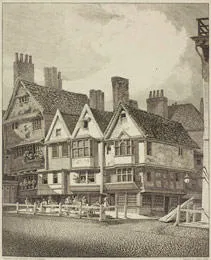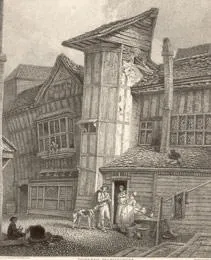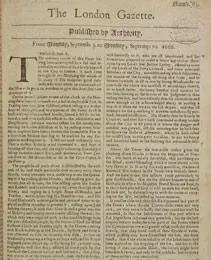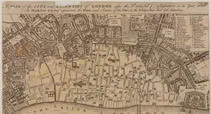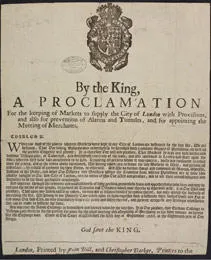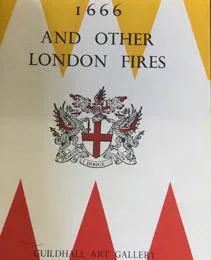Great Fire online exhibition
That Dreadful Fire: the Hand of God, a Great Wind and a Very Dry Season
The Great Fire of London was a devastating event in the City of London, wiping out almost the whole city. It affected the entire population, whether young or old, man or woman, saint or sinner; it changed London forever.
From books and broadsides to official reports and diaries, a mass of information lies hidden at Guildhall Library, waiting to reveal more secrets about this dramatic period of our history.
Using the wide variety of resources at Guildhall Library, this exhibition explores what you can learn about the Great Fire of London in 1666. All material mentioned in this exhibition is available to consult at the library.
The original Guildhall Library exhibition consisted of eight pull-up banners and is available to hire for display. Email Guildhall Library Events, or 020 7332 1869 for further information.
Pre-1666 London was severely over-crowded, with narrow streets and buildings packed close together. John Stow wrote a description of the walled City of London in his 1598 'Survay of London', and the street pattern and timber framed buildings had barely changed by the time of the Great Fire.
London was thriving and there had been an influx of people from the surrounding countryside. In such a densely occupied city, fires were part of everyday life. Each parish had to take responsibility for fire-fighting; there were no fire brigades. Equipment was basic and officials would stop fires by pulling down buildings.
People were aware of the dangers. In 1632, there had been a considerable fire around the northern edge of London Bridge. Nehemiah Wallington, who witnessed this, wrote, 'And this mircie of God I thought on, that there was but little wind… I think it would have indangered the most part of the Citie…'
Advice and recommendations for preventing fire appeared, and John Evelyn, scientist and architect, reported to Parliament on the dangers of fire in 1661. Legislation was passed and in 1664 the King wrote to the Lord Mayor recommending a more diligent execution of the recent building regulation to prevent fire in the city.
From Sunday 2 September the fire raged for three days and consumed most of the City of London. News, rumours and stories spread rapidly around the country through letters and word of mouth. People demanded to know what had happened.
The first major and official account of the fire was in 'The London Gazette', on 10 September, one of the government’s official journals. It was written within a few days of the fire to satisfy the 'minds of so many… who must be concerned for the issue of so great an accident.'
There was also international interest in the fire. In Spain, 'Relacion nueva, y verdadera, del formidable incendio que ha sucedido en 12 dias' ('New, and true relationship, the formidable fire that has happened in 12 days'), was published soon after. The account was written from a Catholic viewpoint, claiming the fire was a judgement from God on London for its Protestantism and the murder of Catholic martyrs.
As well as the official reports and chronicles, the Great Fire was immortalised through literature. John Dryden wrote an historical poem in 1667, 'Annus mirabilis: the year of wonders'. His title 'Year of Miracles', suggested events could have been worse.
The City of London was decimated and over 60,000 inhabitants lost their homes and livelihoods. People quickly moved into the surrounding fields, setting up makeshift camps, or found room in the remaining buildings, or nearby villages.
The destruction of the City is evident in maps and images produced shortly after the fire. Wenceslaus Hollar was commissioned by the King to produce a map of the damage, which helped in the assessment and planning for the rebuilding.
'The Bills of Mortality' also give us an insight into the impact. These bills recorded burials and births in the City every fortnight. In the entry for the 2 to 9 October, there is a dramatic drop in the number of churches listed 'within the walls', from 97 to just 16. Samuel Rolle, who wrote about the fire, described the 'church-yards as consisting of nothing… with waste ground about them.'
Once the shock had worn off, people’s anger soon turned into blame. Many assumed that the fire was started deliberately. England had many enemies and their suspicions fell upon the French and the Dutch.
People also suspected a Catholic plot. Samuel Rolle described London as the 'great bulwark and fortress of protestant interest', so Catholics were easy target. The accusations against Roman Catholics were especially vehement. After the fire there was an outpouring of pamphlet literature, much of it looking for a conspiracy and culprit, but containing little factual evidence. Charges against Roman Catholics were especially vehement.
Despite blaming these individual groups, it was widely accepted that the Fire was a divine judgement on the sin of the people. William Sancroft, Dean of St Paul’s, preached to the King and Court and presented the Fire as a heavy judgement, but also merciful as the destruction could have been much worse.
The Government appointed a committee to look into the causes, which concluded nothing 'had been found to argue it to have been other than the hand of God upon us, a great wind, and the season so very dry.' Even so, Robert Hubert, a French man, was executed for starting the fire after he confessed to it, although no one truly believed in his guilt. The authorities needed a scapegoat. For the French, Dutch and Catholic communities, London had become a dangerous place to live.
There were two challenges facing the King and Government: dealing with the homeless and rebuilding the City. The Guildhall had been burnt and the bureaucracy to carry out this work did not exist.
On 5 September the King published a declaration for the relief and distribution of food, 'that as great proportions of bread and all other can possibly be furnished, shall be daily and constantly brought to the market.' Gresham College was designated the temporary trading and administration centre, substituting the burnt Royal Exchange and Guildhall.
People quickly set up sheds on the plots where they had lived and attempted to carry on with their lives. This was halted until it was decided what form the new city would take. A proclamation issued on 13 September prohibited immediate resettlement and rebuilding and set out guidelines for new buildings.
Within days new designs were put forward for the entire re-planning of London, which included grid-systems, piazzas and boulevards. The most famous design was Christopher Wren’s. However, the authorities did not have the funds to implement these plans and the moreover, city needed its businesses to resume as quickly as possible.
The Great Fire had a huge impact on the City of London and has remained in the collective memory since 1666. It has been marked by sermons, plays and even children’s nursery rhymes.
Annual sermons were preached on the anniversary of the fire to give thanks and to commemorate the disaster. In 1680, Gilbert Burnet, cleric and preacher, gave a Sermon at Bow Church, 'Being the Anniversary Fast for the Burning of London.' This practice continued into the 18th century. Some also used the opportunity to produce more anti-Catholic propaganda, such as, The Burning of London by the Papists, by John Clark in 1714. In the 19th century the fire started to enter popular culture, being produced on the stage, in penny dreadfuls and in cheap historical pamphlets.
The fire remained in the public’s memory throughout the 20th century. 1966 was the 300th anniversary of the Great Fire and it was marked with a major exhibition: '1666 and Other London Fires, at the Guildhall Art Gallery'. The City of London Corporation continues to commemorate the Great Fire and its legacy.
